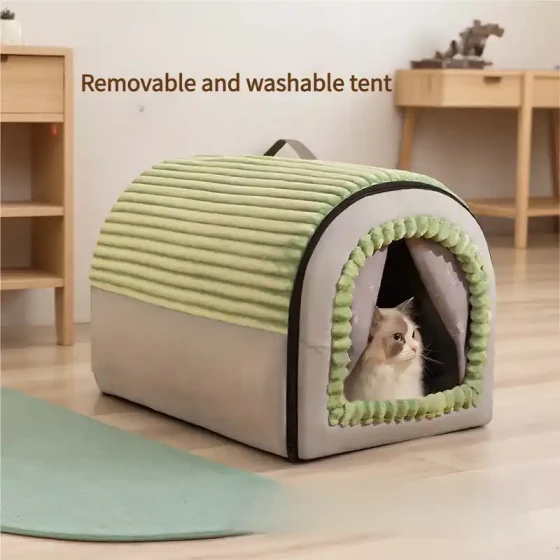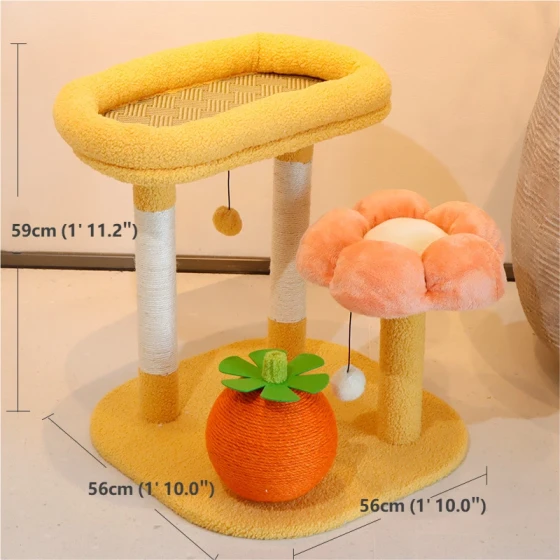Cat Used to Free Range Suddenly Caged_Scientific Training and Emergency Handling Complete Guide
Suddenly putting a cat that is used to roaming freely into a cage is undoubtedly a huge challenge for it, very likely triggering a strong stress response, much like suddenly locking up a person used to "poetry and distant places" into a "small dark room"; the psychological gap is no small matter. Therefore, facing this situation, scientific training and timely emergency handling are vital, not only for the cat’s physical and mental health but also for the harmony in the relationship between us and the cat.

Understanding Why Cats Become Stressed
Cats naturally love freedom and exploration; they need ample space to satisfy their instincts for hunting, patrolling, and climbing. Suddenly being confined to a small cage makes them feel helpless, anxious, and fearful, as if their most precious "sense of security" has been taken away. This sudden environmental change breaks their accustomed routine, triggering a series of stress reactions.
Stress manifestations vary widely, from mild symptoms like loss of appetite, hiding, excessive grooming (even grooming bald spots), to severe symptoms such as inappropriate urination, aggressive behavior, howling, or even urinary system issues and other health conditions. Some cats under extreme stress may even self-harm, scratching and biting the cage until injured.
Scientific Training: Making the Cage a "Safe House" Instead of a "Prison"
Successfully transitioning a free-range cat to cage life requires patience and scientific methods, the core idea being to create positive associations so that the cat sees the cage as a safe and comfortable haven.
- Gradual progression and gentle guidance: Don’t force the door closed at the start. Place the cage in the cat’s usual activity area to allow free exploration. Put the cat’s favorite bedding, toys, and treats inside the cage to lure it in with food. You can also place clothing with the owner’s scent inside to increase familiarity and sense of security.
- Positive reinforcement, reward good behavior: When the cat approaches, touches, or enters the cage, promptly give treats and verbal praise. This positive reinforcement helps the cat understand that entering the cage earns rewards, increasing its willingness to enter. Rewards should be timely, preferably within seconds of the desired behavior.
- Extend time in the cage: When the cat is willing to stay inside, try briefly closing the door for a few seconds while giving rewards, then immediately open it. Gradually extend the duration of the closed door, while staying near the cage so the cat knows you haven’t left.
- Feed inside the cage: Arrange daily feeding inside the cage so the cat associates the cage with positive dining experiences. This effectively enhances the cat’s fondness for the cage.
- Provide a enriched environment: Even inside the cage, enrich the cat’s life by providing comfortable bedding, hiding spaces (such as boxes or cat beds), toys, and rotate them regularly to keep things fresh. If possible, consider using pheromone products (like Feliway) to alleviate anxiety.
- Never use as a punishment tool: Absolutely do not use the cage as a means of punishing the cat. This creates negative associations and is counterproductive.
The whole training process requires great patience and may take days or even weeks to see obvious effects. It is important not to rush. Observe the cat’s reaction; if it shows clear fear or discomfort, stop immediately and revert to the previous step.
Emergency Handling: When Stress Occurs
If the cat already shows clear stress symptoms, timely measures should be taken to alleviate its discomfort:
- Provide a quiet, secluded space: Place the cage in a quiet room with minimal disturbances, and cover parts of the cage with cloth or towels to provide a sense of security. Cats often seek hiding places when stressed.
- Maintain daily routine: Keep the cat’s regular feeding and cleaning routines as much as possible, so it feels familiar and stable.
- Gentle companionship but no forcing: Offer gentle company and speak softly if the cat accepts it. Do not forcefully hold or disturb the cat; respect its wishes.
- Distraction: Use favorite toys or treats to attract its attention and engage in short interactions to help it relax.
- Seek professional help: If the cat’s stress is severe, with prolonged loss of appetite, lethargy, inappropriate urination, etc., consult a veterinarian or professional pet behaviorist promptly. The vet may recommend anxiety relief medications or supplements.
- Check cage environment: Ensure the cage is large enough to hold the cat’s necessities and provides enough activity space. The litter box, food bowl, water bowl, and resting area should be separated as much as possible.
Cage Keeping in Special Circumstances
Although long-term caging is not ideal for cats, in certain special situations, short-term caging is necessary and beneficial:
- Illness treatment: When the cat is sick and needs isolation, observation, or treatment, the cage makes it easier for the owner to care for and monitor the cat.
- Behavior correction: For behavioral problems such as inappropriate urination, short-term caging with a litter box inside helps correct bad habits.
- New cat isolation: A new cat arriving home requires isolated observation to prevent disease spread and conflicts with resident cats.
- Cat mom nursing period: Providing a quiet, safe nursing environment for the cat mother and kittens.
- Travel transport: When taking the cat out for medical visits or travel, the cage is a safe transportation tool.
Under these circumstances, try to choose a spacious and comfortable cage with necessary facilities, and ensure the cat has sufficient daily cage-free activity time whenever possible.
Potential Drawbacks of Long-Term Caging
Keeping a cat confined to a small cage long-term has many adverse effects on its physical and mental health:
- Deprivation of natural instincts: The cat cannot freely explore, climb, or hunt, suppressing its instincts and possibly leading to depression and behavioral issues.
- Lack of exercise: Long-term confinement results in inadequate exercise, increasing risk of obesity and affecting physical health.
- Mental issues: The cat may become timid, nervous, unaffectionate, or conversely, agitated and aggressive. Lack of environmental stimulation can also cause boredom and stress.
- Social problems: Lack of interaction with people or other animals may impair social skills.
- Hygiene issues: If the cage is too small or not cleaned timely, poor hygiene can lead to health problems.
Therefore, unless there is a special reason, long-term caging of cats is not recommended. If necessary, ample space, enriched environments, and sufficient time outside the cage must be provided.
Frequently Asked Questions
- What to do if the cat keeps crying after being caged?
This reflects stress and unease. First check if the cage is comfortable, provide water, food, and litter box. Try soothing it with a gentle voice or offer favorite toys. If howling persists, stress might be severe; emergency measures mentioned above should be taken and professional advice sought if needed. - How to help cats not fear the cage?
Use gradual positive training so the cat associates the cage with pleasant things (treats, toys, comfortable bedding) and feels it is a safe and relaxing place. - What are the dangers of long-term caging?
Long-term caging suppresses the cat’s instincts, causing insufficient exercise, obesity, and potential psychological and behavioral issues. - Can a litter box be placed inside the cage?
If the cage is large enough, the litter box can be placed inside, but it should be as far away from the food and water bowls as possible.
Summary
Suddenly caging a cat used to free roaming is quite a test. As responsible pet owners, we need to understand the potential stress and discomfort cats face and use scientific training to turn the cage from an unfamiliar confined space into a reassuring "safe house." At the same time, mastering emergency handling methods ensures timely help when stress occurs. Remember, patience, understanding, and love are the best remedies to help cats adapt to new environments.





